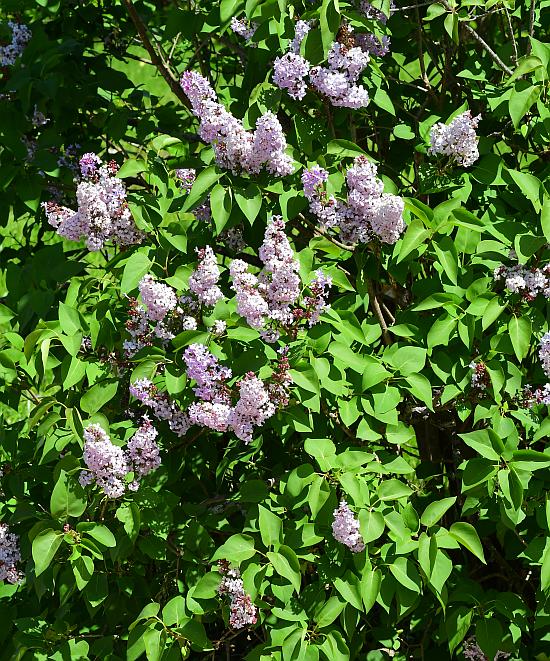Syringa vulgaris L.
Common Lilac

Introduced
CC = *
CW = 5
MOC = 6
© SRTurner
Syringa vulgaris L.Common Lilac | |
 |
Introduced CC = * CW = 5 MOC = 6 |
© SRTurner |
|
Family - Oleaceae Habit - Shrub, to 3 m. Stem - Trunks few to several, ascending, the bark gray or grayish brown, thin, relatively smooth, but with raised leaf scars and lenticels. Twigs relatively stout, reddish brown to dark brown, with a pale, waxy coat, tending to peel in strips with age, glabrous, more or less 4-angled in cross-section, the leaf scars raised and the lenticels conspicuous and raised. Terminal buds usually absent, suppressed by an apical pair of relatively large axillary buds, these ovoid to broadly ovoid, with scales that are broadly but sharply pointed at the tips (those lower on the twigs similar, but smaller).
Leaves - Opposite, simple, entire, glabrous, petiolate. Petioles to 30 mm long. Leaf blades 3-10 cm long, 1-6 cm wide, ovate, tapered to the sharply pointed tip, broadly rounded to truncate or shallowly cordate at the base, the upper surface green to dark green, the undersurface lighter green.
Inflorescence - Terminal (often paired) panicles, many-flowered, ascending to spreading or drooping, 8-20 cm long developing with or after the leaves, the lower branch points with small, leaflike or scalelike bracts, the flowers with slender stalks 1-4 mm long, strongly fragrant.
Flowers - Calyces shallowly 4-lobed, 1.5-2.2 mm long, the lobes triangular, often toothlike. Corollas 4-lobed, 9-16 mm long, trumpet-shaped, the lobes oblong to oblong-elliptic, purple to bluish lavender, pale lavender, or rarely white. Style 1.5-2.5 mm long, with a pair of ascending branches at the tip.
Fruits - Capsules, 10-18 mm long, slightly flattened, not winged, oblanceolate to narrowly obovate in outline, beaked, brown, glabrous, often somewhat shiny, dehiscing longitudinally. Seeds 10-14 mm long, flattened, narrowly winged toward the midpoint, tapered at each end, brown.
Flowering - April - June. Habitat - Forest edges, old homesites, roadsides. Origin - Native to Europe. Lookalikes - None close. Other info. - Occurrences of this familiar shrub in Missouri are usually remnants from deliberate cultivation. These plantings can persist for many years, although in Missouri the species rarely reproduces itself or escapes cultivation. It (in numerous horticultural forms) has been long been popular as a landscaping ornamental, and it is found across the country. The inflorescences are large and showy, and strongly fragrant when at their peak. Cultivars have been developed which vary in flower color, flower structure (single and double flowers), growth form, and disease resistance. Conventional wisdom suggests that the older varieties are often the most aromatic. The fragrance, due to a mixture of furanoterpenoids, is sold as an essential oil and is used extensively in perfumes, soaps, bath products, scented candles, and potpourri. Photographs taken at Don Robinson State Park, Jefferson County, MO, 4-23-2019, Little Lost Creek Conservation Area, Warren County, MO, 4-14-2021, near Pacific, St. Louis County, MO, 4-15-2021, and near Couer d'Alene, Kootenai County, ID, 7-20-2021 (SRTurner). |